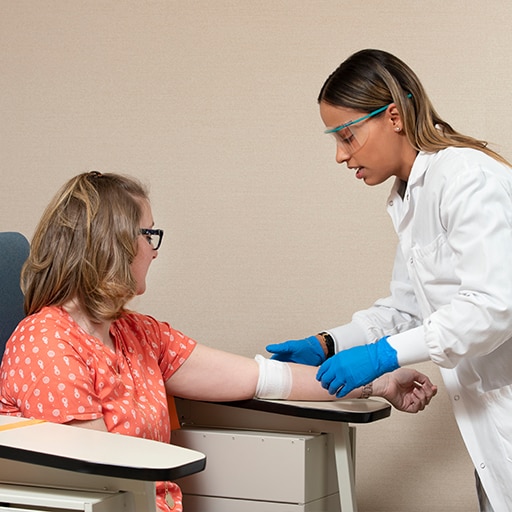The 5-Second Trick For Northeast Medical Institute - New Haven Campus Phlebotomy Course & Cna Class
The 5-Second Trick For Northeast Medical Institute - New Haven Campus Phlebotomy Course & Cna Class
Blog Article
Northeast Medical Institute - New Haven Campus Phlebotomy Course & Cna Class Things To Know Before You Buy
Table of ContentsAll about Northeast Medical Institute - New Haven Campus Phlebotomy Course & Cna ClassNot known Details About Northeast Medical Institute - New Haven Campus Phlebotomy Course & Cna Class The Single Strategy To Use For Northeast Medical Institute - New Haven Campus Phlebotomy Course & Cna Class5 Easy Facts About Northeast Medical Institute - New Haven Campus Phlebotomy Course & Cna Class DescribedSome Ideas on Northeast Medical Institute - New Haven Campus Phlebotomy Course & Cna Class You Should KnowNortheast Medical Institute - New Haven Campus Phlebotomy Course & Cna Class Fundamentals Explained
However, the usage of such tools should be gone along with by various other infection avoidance and control techniques, and training in their use. Not all security devices are suitable to phlebotomy. Before choosing a safety-engineered device, individuals need to extensively investigate readily available gadgets to determine their ideal use, compatibility with existing phlebotomy practices, and efficacy in securing personnel and individuals (12, 33).For settings with low resources, cost is a motoring consider purchase of safety-engineered gadgets - PCT Classes. Where safety-engineered tools are not readily available, experienced use of a needle and syringe is acceptable. Unexpected direct exposure and details information concerning an event should be recorded in a register. Assistance solutions should be promoted for those that undertake unintentional direct exposure.
Among the necessary markers of quality of care in phlebotomy is the participation and teamwork of the patient; this is equally helpful to both the wellness worker and the person. Clear information either written or verbal must be offered to each patient that undertakes phlebotomy. Annex F provides example text for explaining the blood-sampling treatment to an individual. In the blood-sampling area for an outpatient department or facility, offer a comfortable reclining couch with an arm remainder.
The Best Strategy To Use For Northeast Medical Institute - New Haven Campus Phlebotomy Course & Cna Class
Ensure that the signs for blood sampling are clearly specified, either in a written procedure or in documented directions (e.g. in a lab type). Gather all the devices needed for the treatment and location it within risk-free and easy reach on a tray or trolley, guaranteeing that all the things are clearly noticeable.
Present yourself to the client, and ask the client to specify their full name. Examine that the research laboratory kind matches the client's identity (i.e. match the person's details with the lab form, to make certain exact recognition).
Make the client comfy in a supine setting (if feasible). The person has a right to decline an examination at any time prior to the blood sampling, so it is vital to make sure that the individual has actually understood the treatment - Phlebotomy Training.
10 Easy Facts About Northeast Medical Institute - New Haven Campus Phlebotomy Course & Cna Class Described
Expand the person's arm and check the antecubital fossa or forearm. Locate a capillary of a great size that is noticeable, straight and clear. The diagram in Section 2.3, shows typical settings of the vessels, however lots of variants are possible. The median cubital vein lies between muscle mass and is normally one of the most very easy to puncture.
DO NOT put the needle where blood vessels are drawing away, because this raises the chance of a haematoma. Situating the capillary will aid in establishing the correct dimension of needle.
Haemolysis, contamination and existence of intravenous liquid and medication can all modify the outcomes (39. Nursing team and medical professionals might access central venous lines for samplings adhering to procedures. Specimens from main lines bring a threat of contamination or wrong laboratory examination results. It serves, however not perfect, to injure specimens when very first presenting an in-dwelling venous gadget, prior to attaching the cannula to the intravenous liquids.
Unknown Facts About Northeast Medical Institute - New Haven Campus Phlebotomy Course & Cna Class
Failure to enable sufficient call time increases the threat of contamination. DO NOT touch the cleansed website; in particular, DO NOT place a finger read here over the vein to guide the shaft of the exposed needle.
Ask the client to form a clenched fist so the blood vessels are much more popular. Enter the vein promptly at a 30 degree angle or less, and remain to present the needle along the blood vessel at the most convenient angle of entry - CNA Classes. As soon as enough blood has actually been accumulated, release the tourniquet BEFORE withdrawing the needle
The Greatest Guide To Northeast Medical Institute - New Haven Campus Phlebotomy Course & Cna Class
Take out the needle gently and apply mild stress to the site with a tidy gauze or dry cotton-wool round. Ask the person to hold the gauze or cotton wool in area, with the arm prolonged and raised. Ask the person NOT to bend the arm, due to the fact that doing so triggers a haematoma.

All about Northeast Medical Institute - New Haven Campus Phlebotomy Course & Cna Class
Do not push the syringe plunger since additional pressure raises the risk of haemolysis. Where possible, keep televisions in a rack and move the shelf in the direction of you. Infuse downwards right into the proper coloured stopper. DO NOT get rid of the stopper because it will launch the vacuum cleaner. If the example tube does not have a rubber stopper, infuse incredibly slowly into the tube as minimizing the pressure and rate made use of to transfer the sampling minimizes the risk of haemolysis.

Report this page